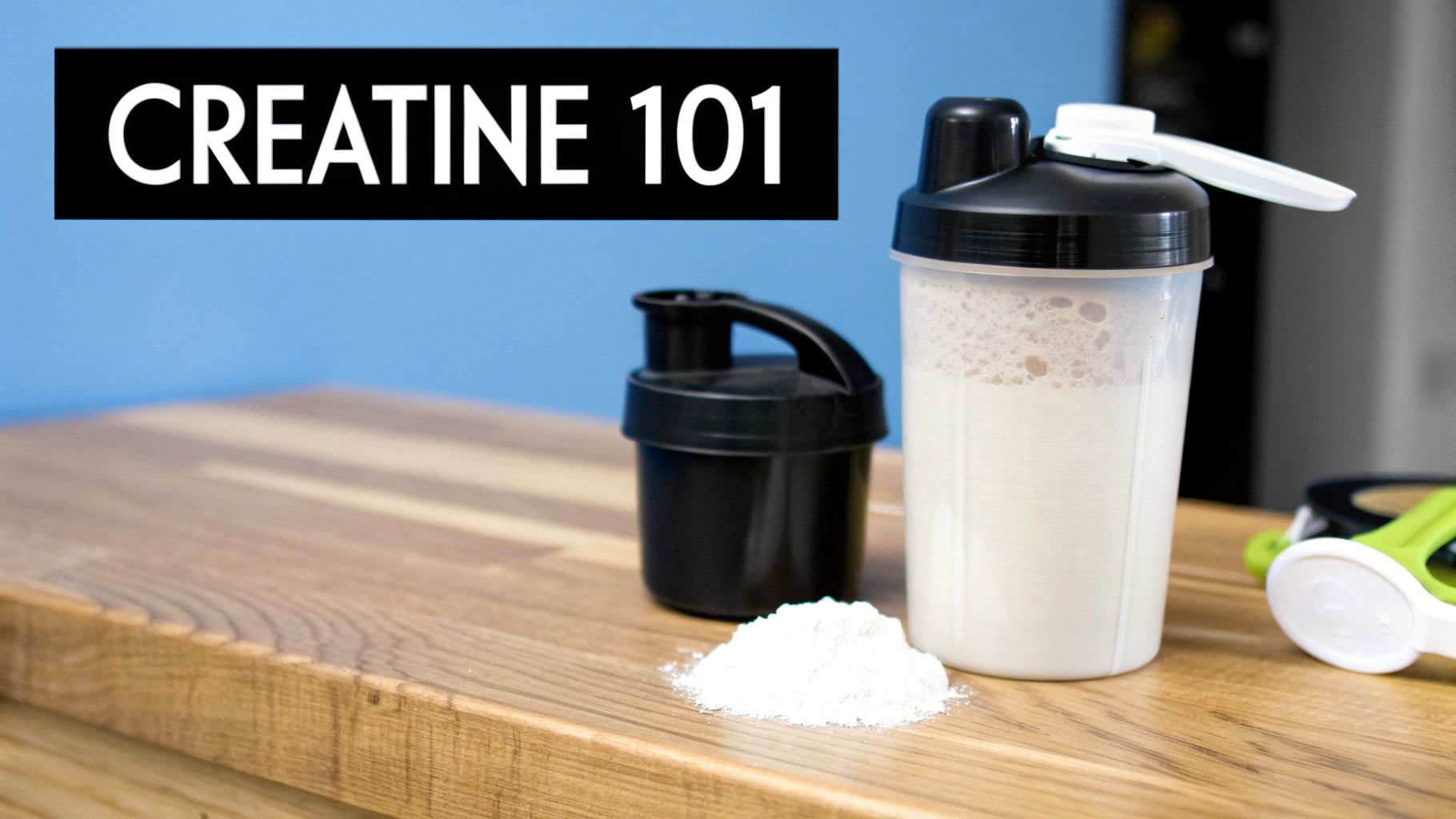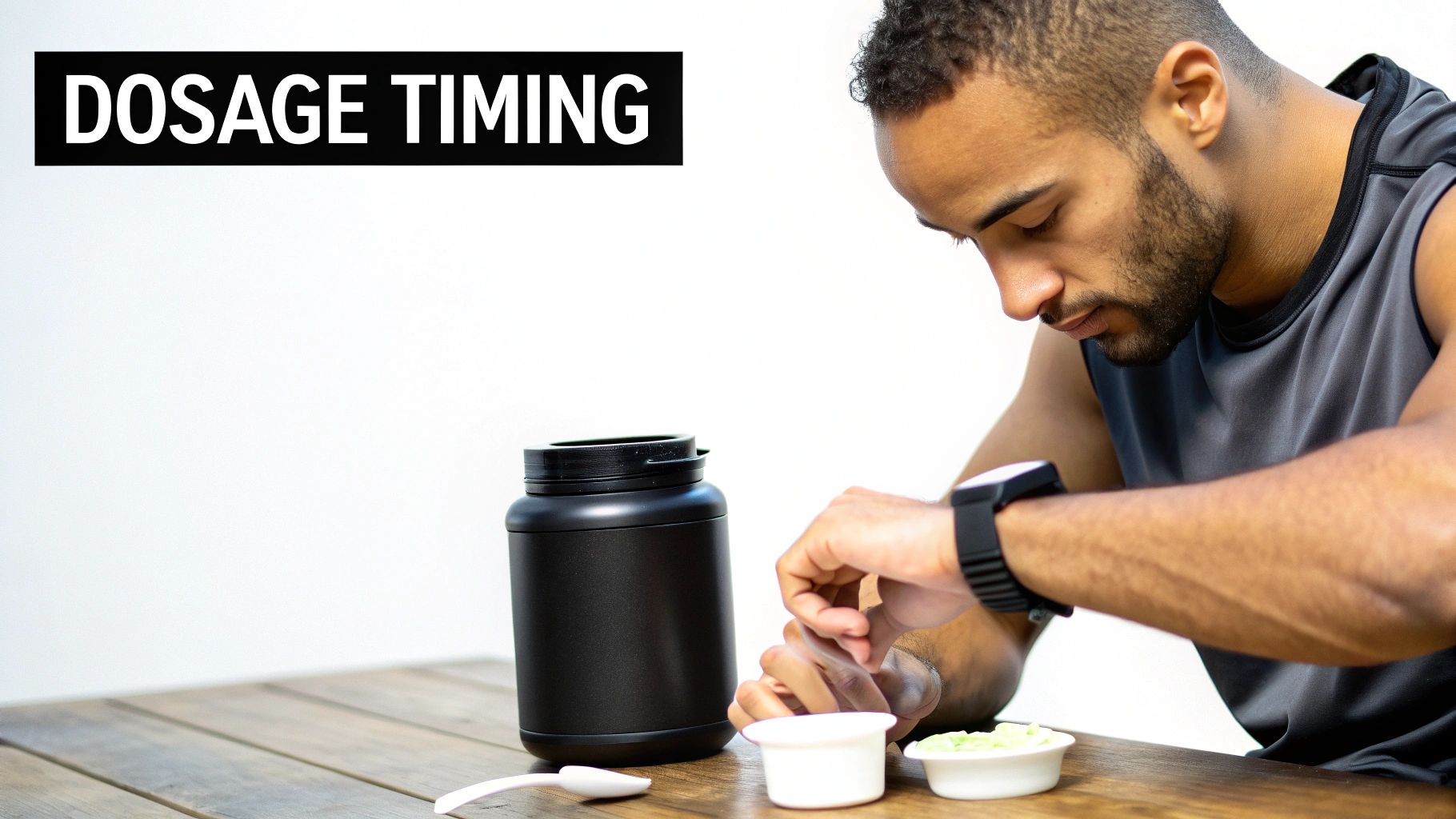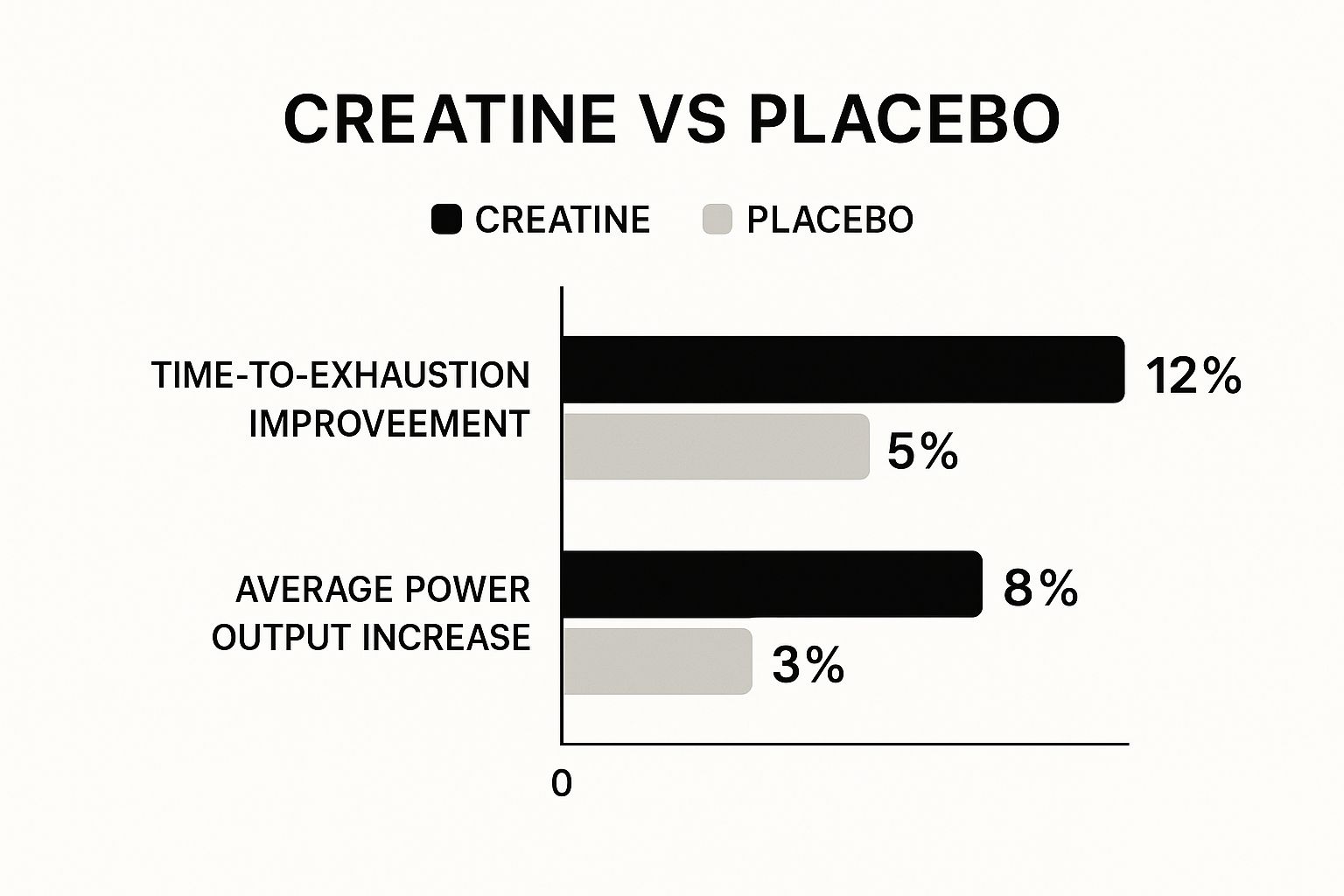
Creatine for Endurance Athletes Ultimate Guide
Share
For years, creatine got stuck with a bad rap—pigeonholed as a supplement just for bodybuilders chasing sleeve-splitting biceps. But if you’re a runner, cyclist, or triathlete, it’s time to take another look. The science is clear: using creatine for endurance athletes isn’t just a fringe idea; it’s a smart strategy for boosting performance when it counts.
This isn’t about bulking up. It’s about the science of sustained power.
Why Creatine Is Not Just for Powerlifters

Let's clear the air right away. The idea that creatine only belongs in a shaker cup next to a squat rack is completely outdated. That misconception comes from its primary job: fueling short, explosive movements. And while it’s fantastic for that, the story doesn't end there.
Think about the most critical moments in your sport. That final sprint to the finish line, a sharp climb on the bike, or a breakaway from the pack—those all tap into the exact same quick-energy system a powerlifter uses for a heavy squat. Creatine is the master recharger for that system.
The Energy Recharge Analogy
Imagine your muscles have tiny, super-fast batteries for all-out efforts. The problem is, they run out of juice in just a few seconds. Creatine acts like a high-speed charging dock, rapidly refilling those batteries so you can go again, and again, and again.
This is huge for endurance athletes. Even though most of a race is spent at a steady, aerobic pace, the moments that make or break your performance are almost always anaerobic bursts.
Creatine’s real magic for endurance isn't about helping you jog for hours. It’s about giving you the firepower to go harder during the most decisive parts of a race or workout.
With fully charged batteries, you can attack intervals with more pop, hold your form on a brutal hill, and still have something left in the tank for a strong finishing kick. Over a training block, those repeated high-quality efforts are what lead to major breakthroughs.
More Than Just a Sprint Boost
The benefits don't stop at a stronger kick, either. Research has shown that even well-trained triathletes see significant gains in muscle power and strength from creatine. Studies have found notable increases in cycling sprint power after just a few weeks of supplementation, which translates directly to handling those high-intensity surges in a race.
These findings show how a little extra power can make you a more efficient and resilient athlete.
At the end of the day, creatine helps you raise your training ceiling. It gives you the ability to push harder in key workouts, recover faster between intervals, and ultimately build a stronger foundation for long-distance success.
Here's a quick rundown of what matters most for endurance athletes.
Creatine At A Glance For Endurance Athletes
This table gives you a quick snapshot of why creatine deserves a spot in your supplement strategy.
| Key Benefit | How It Helps Endurance | Best For |
|---|---|---|
| Increased Power Output | Helps you produce more force during high-intensity bursts, like sprints, climbs, and surges. | Athletes in sports with repeated high-effort intervals (cycling, HIIT, team sports). |
| Enhanced Glycogen Storage | Can help muscles store more glycogen (carbohydrate fuel) when taken with carbs. | Marathon runners, triathletes, and anyone focused on carb-loading pre-race. |
| Improved Recovery | Reduces muscle damage and inflammation, helping you bounce back faster from hard training sessions. | All endurance athletes, especially during intense training blocks or multi-day events. |
| Better Heat Tolerance | Helps with hydration by pulling water into muscle cells, potentially improving performance in hot conditions. | Athletes training or competing in hot and humid environments. |
In short, creatine provides a multi-faceted advantage, touching on everything from raw power to better fueling and recovery.
How Creatine Fuels Your Endurance Engine

To really get how creatine helps with endurance, we need to pop the hood on your body’s energy systems. Let's skip the complicated science diagrams and think about it more practically. Your muscles have one primary fuel for quick, powerful movements: adenosine triphosphate (ATP).
ATP is your "right now" energy. It’s the juice your muscles burn for those first few seconds of a sprint, that initial surge up a hill, or any explosive effort. Think of it as pure, instant power.
But there’s a catch. Your body only keeps a tiny amount of ATP on hand, just enough for a few seconds of all-out work. Once you use it, it turns into adenosine diphosphate (ADP), which is basically a dead battery. This is where creatine jumps in to save the day.
The Ultimate Battery Recharger
Imagine your muscle cells are packed with tiny rechargeable batteries (ATP). Every time you sprint or surge, you drain them almost instantly.
This is where creatine, which is stored in your muscles as phosphocreatine, becomes your secret weapon. It acts like a high-speed charging dock. It holds onto a special phosphate molecule and, when it sees a drained ADP battery, it slaps that phosphate right back on.
Boom. That dead ADP is instantly converted back into a fully charged ATP molecule, ready to go again. By supplementing with creatine, you’re essentially stocking your muscles with more of these fast-charging stations.
Saturating your muscles with creatine gives you a much bigger and faster energy recycling system. This means you can sustain those high-intensity bursts for longer and bounce back quicker between them.
This whole process is your body's phosphocreatine (PCr) system. It’s your go-to energy source for any intense effort that lasts up to about 10-15 seconds.
Connecting Short Bursts to Long Distances
Right now, you’re probably thinking, "Great, but my race lasts for hours, not 15 seconds." And you're absolutely right. But think about it—endurance events are rarely about maintaining one single, steady pace. They're won and lost in the moments that demand a sudden burst of power.
These are the moments that rely entirely on that ATP system:
- Runners: Surging up a short, steep hill to keep your momentum.
- Cyclists: Launching an attack to break away from the pack.
- Triathletes: Unleashing a powerful finishing kick in the final stretch.
- Trail Runners: Making quick, explosive steps to get over technical terrain.
In every one of these scenarios, you're tapping into your immediate ATP stores. An athlete with topped-off creatine levels can execute these moves with more force and repeat them more often before hitting a wall.
This ability to repeatedly produce high-power outputs is what separates the good from the great. For a deeper dive into this, check out our guide on creatine and cardio.
Raising Your Overall Work Capacity
The real magic happens over weeks and months of training. When you can consistently push harder in your workouts, you’re giving your body a stronger signal to adapt and get fitter.
Let’s say creatine helps you nail 10 hard intervals in a key session instead of sputtering out at eight. You’ve just increased the quality and volume of your training. Do that consistently, and the long-term fitness gains are huge.
This is the real value of creatine for endurance athletes. It’s not about making the easy miles feel easier. It's about empowering you to crush the hard parts, which ultimately raises your entire performance ceiling. You recover faster between surges, which means you can hold a higher average pace for the whole event.
Translating Science Into Real-World Performance

It’s one thing to understand the science of creatine, but it's another to feel it on the track, the road, or the trail. That's where it all clicks. The theoretical perks, like faster ATP regeneration, show up as real, measurable improvements in your training and racing.
For endurance athletes, this isn’t about hitting a one-rep max. It’s about sustaining power when it matters most. Think about the repeated surges in a criterium, those punchy climbs on a trail run, or the final 400 meters of a 5k. Those are the moments that make or break your race.
Creatine helps by keeping your immediate energy stores topped off, so you can attack those efforts with more pop and bounce back faster between them. This means you can hold a higher average pace, cover a competitor's move, and still have something left in the tank for a finishing kick.
Stronger Intervals and a Fiercer Finishing Kick
The most obvious impact you'll see from creatine is a boost in your capacity for high-intensity work. During a tough interval session, your ability to nail the pace on those last few reps is what forces your body to adapt. Creatine helps you keep that quality high from the first interval to the very last.
This pays huge dividends on race day. A marathoner with fully saturated creatine stores might find they can power up a late-race hill without going into the red. A cyclist will have more "matches" to burn for repeated attacks and sprints during a long road race.
Creatine’s core benefit is simple: it helps you go harder, more often, during the most critical moments of your training and racing, which compounds into significant long-term fitness gains.
And this isn't just theory; the research backs it up. One study found that creatine boosted work capacity during intense efforts lasting anywhere from 90 to 600 seconds. Another showed a performance jump of nearly 20 seconds during all-out tasks, proving its value when you really need to dig deep.
Accelerating Recovery Between Hard Efforts
Performance gains aren't just about what you do during a workout—they're also about how well you recover from it. Creatine has been shown to reduce markers of muscle damage and inflammation after you’ve put in a hard effort.
What this means for you is a quicker bounce-back. Instead of feeling sore and lead-legged for days after a key session, you’ll be ready for your next one sooner. Over an entire training block, this accelerated recovery leads to more consistency and a higher total volume of quality work.
- Reduced Muscle Soreness: Less downtime from soreness means you can get back to productive training faster.
- Enhanced Glycogen Resynthesis: Some evidence suggests creatine, when taken with carbs, helps your muscles restock their primary fuel (glycogen) more quickly.
- Improved Training Quality: By recovering faster, you can bring more energy to each workout, driving better and better adaptations over time.
Many athletes track their recovery using advanced tools like Heart Rate Variability (HRV) to see how their body is handling the training load. Faster recovery, supported by supplements like creatine, will often show up as a positive trend in these metrics.
Ultimately, creatine acts as a powerful training amplifier. It helps you handle a tougher workload, recover from it more effectively, and show up to your next session ready to go. That virtuous cycle is exactly what you need to unlock a new level of performance.
Improving Your Metabolic Efficiency to Delay Fatigue
Beyond just fueling quick bursts of power, creatine has a quieter, more strategic benefit for endurance athletes: it helps your body become a more efficient engine. This upgrade in metabolic efficiency is a total game-changer, especially deep into a long race where every drop of conserved energy matters.
It helps you delay that all-too-familiar moment when your legs start burning and your lungs are screaming—the point where fatigue forces you to back off the pace.
Think of it like pushing your body's "redline" further down the track. Creatine helps you hold a faster pace for much longer before your muscles start begging you to slow down.
Raising Your Lactate Threshold
One of the main ways creatine boosts your efficiency is by raising your lactate threshold. This is the specific intensity where lactate—the byproduct often (and incorrectly) blamed for muscle soreness—starts to accumulate in your blood faster than your body can clear it out.
Having a high lactate threshold is a defining trait of top-tier endurance athletes.
Picture two runners. Runner A has a low lactate threshold and starts feeling that heavy, burning sensation when they hit a 7:30-minute mile pace. But Runner B, with a much higher threshold, doesn't hit that wall until they're cruising at a 7:00-minute mile. Runner B can simply hold a faster pace with far less physiological stress.
Creatine helps you become more like Runner B. By fine-tuning your muscle's energy recycling system, it lessens the need to rely on anaerobic glycolysis at higher intensities, which is the very process that pumps out lactate. This means you can operate at a higher output before ever crossing that critical point.
Less Strain for the Same Pace
What does this enhanced metabolic efficiency feel like in the real world? It means running an eight-minute mile might feel noticeably easier and demand less from your body than it did before you started taking creatine.
The implications for your training and racing are huge:
- Better Training Quality: You can tackle tougher workouts without completely wrecking your system, paving the way for bigger fitness gains over time.
- Smarter Pacing: You can start a race at a more aggressive pace without the constant fear of bonking before the finish line.
- A Stronger Finish: When you conserve energy throughout the early and middle stages of a race, you have way more left in the tank for a powerful finishing kick.
The science backs this up. A study on elite male rowers, for instance, found that after just five days of creatine supplementation, they had significantly lower blood lactate levels at submaximal efforts and a higher overall lactate threshold. Other studies have shown improvements of around +6.7% in critical power and +6% in ventilatory threshold.
The bottom line is simple: this increased efficiency allows you to go faster, for longer, before fatigue crashes the party. That's the absolute cornerstone of endurance performance.
Of course, this efficiency boost works best when it's part of a solid overall fueling plan. To understand how to structure your diet for peak performance, our complete guide on nutrition for endurance athletes is a must-read. It will help you combine the metabolic benefits of creatine with the right fuel to get the best possible results. In the end, creatine doesn’t just help you push harder—it helps you work smarter.
Implementing Your Creatine Dosing Protocol
Alright, you're sold on the benefits of creatine. Smart move. But knowing why it works is only half the battle—now you need to know how to make it work for you. Let's get into the practical side of things and figure out the best dosing strategy for your goals.
There are really two proven ways to go about it: the fast track and the steady route. Neither is right or wrong, they just get you to the same destination on a different timeline. It all comes down to how quickly you want to see results and what feels best for your body.
The Loading Phase: Rapid Saturation
Think of this as the express lane to full muscle saturation. The goal of a loading phase is to fill up your muscles' creatine stores as quickly as humanly possible. To do this, you’ll take a higher dose for a short burst before tapering down to a smaller daily amount.
Here’s the game plan:
- The Dose: Take a total of 20 grams of creatine per day.
- The Schedule: Don't chug it all at once. Split that 20 grams into four smaller 5-gram servings spread throughout the day. This helps with absorption and is much easier on your stomach.
- The Duration: Keep this up for about 5-7 days.
Once that week is up, you’ll switch to a daily maintenance dose to keep those levels topped off. This is, hands down, the fastest way to start feeling the performance boost.
The Maintenance Dose: Steady and Simple
If the loading phase is the express lane, think of this as the scenic route. You skip the high-dose week and jump straight into a daily maintenance dose. It's a simpler, gentler approach that gets you to the exact same place, just a bit slower. You’re not flooding the tank; you're just consistently topping it off, day after day.
- The Dose: Take a single, consistent dose of 3-5 grams per day.
- The Schedule: One serving a day, whenever it’s most convenient for you.
- The Duration: This is your new normal—an ongoing daily habit.
With this method, you can expect to reach full muscle saturation in about 3-4 weeks. It's a fantastic choice for anyone who isn't prepping for an imminent race or just prefers a more gradual approach.
This visual shows you just how big of a difference creatine can make compared to a placebo. The proof is in the performance.

The numbers don't lie. Athletes taking creatine saw significantly bigger gains in their time-to-exhaustion and average power output. That’s a real, measurable edge.
What About The Dreaded Weight Gain?
Let's tackle the elephant in the room. You've probably heard that creatine makes you gain weight, which can sound terrifying for an endurance athlete. It’s true you might see the scale go up by 1-2% during a loading phase, but it’s critical to understand what that weight actually is.
This initial increase is not fat. It's water being drawn into your muscle cells along with the creatine. This process, called cell volumization, is actually a sign that it’s working exactly as it should.
For nearly every athlete, the trade-off is a massive win. A tiny bit of temporary water weight is nothing compared to the substantial improvements in power, stamina, and overall training quality you'll experience. Once you settle into your maintenance dose, this effect levels off. Over the long haul, the better workouts you'll be able to crush will lead to a far superior power-to-weight ratio.
To help you decide, here’s a quick side-by-side comparison of the two strategies.
Creatine Dosing Strategy Comparison
| Strategy | Daily Dosage | Duration | Pros | Cons |
|---|---|---|---|---|
| Loading Phase | 20g (split into 4 doses) | 5-7 days, then maintenance | Fast results, full saturation in a week | Can cause GI distress in some, temporary water weight gain |
| Maintenance Dose | 3-5g | Ongoing | Simple, minimal side effects, effective long-term | Slower to reach full saturation (3-4 weeks) |
Ultimately, there's no wrong answer here. If you have a big race or a tough training block on the horizon, loading gets you results faster. If you prefer to keep things simple and steady, the maintenance-only approach is just as effective over time.
For a more comprehensive look at dosing, check out our creatine dosage guide from beginner to expert results. Whichever path you take, the real secret to unlocking creatine’s benefits is consistency. Stick with it, and you'll feel the difference.
Common Questions About Creatine for Endurance
It’s only natural to have questions before adding a new supplement to your regimen. The world of sports nutrition is a noisy place, packed with marketing hype, bro-science, and conflicting advice that can leave your head spinning.
This section is here to cut through all that noise. We’re going to tackle the most common questions and concerns endurance athletes have about creatine, armed with straight-up, science-backed answers. Let's clear the air on everything from the dreaded "weight gain" myth to which type of creatine is actually worth your money.
Will Creatine Cause Weight Gain and Hurt My Performance?
This is, without a doubt, the number one hang-up for runners, cyclists, and triathletes. The short answer is yes, you might see a small initial bump on the scale, but it’s absolutely not the kind of weight you’re thinking of.
When you first start taking creatine, especially with a loading phase, it's common to gain 1-2% of your body weight. This isn't fat. It's just water. Creatine works by pulling water into your muscle cells along with it, a process called cell volumization. This is actually a great sign—it means your muscles are fully saturated and primed to perform.
Think of it like this: a plump, hydrated grape is healthier and functions better than a shriveled-up raisin. That initial water weight is a sign of properly hydrated, high-performing muscles.
For nearly every athlete, the performance boost from creatine—more power, better fatigue resistance, a higher training capacity—easily outweighs this minor, temporary water gain. Once you settle into a steady maintenance dose, your weight will stabilize. Over the long haul, the improved training quality you get from creatine can actually lead to a better power-to-weight ratio.
Which Type of Creatine Is Best?
Walk down the supplement aisle and you’ll be hit with a dozen different forms of creatine, all claiming to be the next big thing. You'll see creatine HCL, ethyl ester, buffered formulas, and liquid concoctions, all promising superior absorption and fewer side effects.
Here’s the simple truth: you can ignore almost all of them.
Creatine monohydrate is the undisputed king. It’s the most researched sports supplement on the planet, with hundreds of studies confirming its safety, effectiveness, and bioavailability. It’s the gold standard for a reason. While newer, pricier forms make impressive claims, there's virtually no independent scientific proof that they outperform good old-fashioned monohydrate.
To get the most bang for your buck, look for micronized creatine monohydrate. "Micronized" just means the powder has been milled into smaller particles. This helps it dissolve better in water and can be a little easier on the stomach for some people. It's cheap, proven, and it works.
Does Creatine Cause Cramping or Dehydration?
This is another stubborn myth that has been thoroughly debunked by research. The idea came from a simplistic (and incorrect) assumption: if creatine pulls water into the muscles, it must be stealing it from other parts of the body, leading to cramps.
Modern studies actually show the complete opposite is true. Time and time again, research on athletes exercising in the heat has found that creatine supplementation does not increase the risk of cramping or dehydration. In fact, by improving how well your cells hold water, creatine may actually help your body regulate its temperature and improve performance in hot, humid weather.
So where did the myth come from? It probably started with anecdotal stories from athletes who were simply not drinking enough water to begin with. If you're training hard, you need to be on top of your hydration game—creatine or no creatine. As long as you maintain smart hydration habits, creatine is perfectly safe and won't cause cramps.
Should I Cycle On and Off Creatine?
The idea of "cycling" supplements—using them for a while, then taking a break—is a common strategy for things the body might build a tolerance to. But creatine doesn't work that way.
There is no scientific evidence that your muscles become less responsive to creatine over time. While it's true that your body’s natural production dips a bit while you’re supplementing, it bounces right back to normal levels if you stop. Using it continuously doesn't cause any harm or make it less effective down the road.
For an endurance athlete, cycling off creatine is actually counterproductive. The very benefits you're taking it for—faster recovery, higher training capacity, better metabolic efficiency—are most valuable when they're always there. To keep your muscle stores topped off and reap the rewards day in and day out, a consistent daily maintenance dose of 3-5 grams is the way to go. Think of it less like a temporary boost and more like a daily staple for performance.
Ready to fuel your performance with the most convenient and delicious creatine on the market? Smash.com offers premium creatine gummies that deliver your full 5-gram daily dose without the mess of powders or shakers. Perfect for your on-the-go lifestyle, our gummies are made in the USA, 3rd party tested, and designed to help you smash your goals.
Upgrade your supplementation game with Smash.com Creatine Gummies today!